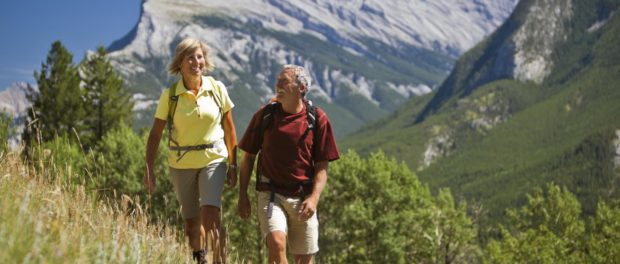Knee instability treatment may help older adults prevent falls
Interventions that reduce knee buckling may help prevent falls, fall-related injuries and adverse psychological consequences of falls in persons with knee OA.

Hikers in Banff National Park
Symptoms of knee instability in older adults may indicate an increased risk of falling and of experiencing the various physical and psychological effects that can result from falling, according to a study published in Arthritis Care & Research, a journal of the American College of Rheumatology (ACR). The findings indicate that determining effective treatments for knee instability should be an important priority as clinicians care for aging patients.
Knee buckling, often described as a knee “giving way,” is a symptom of knee instability that frequently affects older individuals, in particular those with knee pain and knee osteoarthritis (OA), and may be caused by muscle weakness and balance difficulties. If knee instability leads to frequent falls and fall-related injuries, exercises and other interventions that stabilize the knee may help maintain older individuals’ health and quality of life. To investigate this potential link, Michael Nevitt, PhD, of the University of California, San Francisco, and his colleagues prospectively studied 1842 participants in the Multicenter Osteoarthritis Study (MOST) who were an average of 67 years old at the start and who had, or were at high risk for, knee osteoarthritis.
At the end of 5 years, 16.8 percent reported knee buckling, and at the end of 7 years, 14.1 percent had recurrent (?2) falls. Bucklers at year 5 had a 1.6- to 2.5-times higher likelihood of recurrent falls, fear of falling, and poor balance confidence at year 7. Those who fell when a knee buckled at the start of the study had a 4.5-times, 2-times, and 3-times higher likelihood 2 years later of recurrent falls, significant fall injuries, and fall injuries that limited activity, respectively, and they were 4-times more likely to have poor balance.
“Falls, injury from falls and poor balance confidence are extremely common and debilitating problems in older people. The present study has demonstrated for the first time that knee instability and knee buckling are important causes of these problems in the very large segment of the older population suffering from knee pain,” said Dr. Nevitt. “Fortunately, it may be possible to treat knee instability and prevent knee buckling with targeted exercises. Joint replacement surgery can also improve knee stability.” He added that pain is the predominant symptom of knee osteoarthritis, and symptoms of instability such as knee buckling and falls may be overlooked by treating professionals.
The most important immediate impact of these findings on patient care is that health professionals should query their patients with knee OA about instability, buckling, and falls, and work with them to take preventive actions, including proper use of walking aids, leg strengthening, and appropriate footwear.”
Source EurekAlert! AAAS via Science Daily and Endocrinology Advisor
| References |
Symptoms of Knee Instability are Risk Factors for Recurrent Falls, Michael C. Nevitt, Irina Tolstykh, Najia Shakoor, Uyen S. Nguyen, Neil A. Segal, Cora Lewis, David T. Felson. Arthritis Care & Research, 2015; DOI: 10.1002/acr.22811.
| Further reading |
Falls in the community-dwelling older adult: A review for primary-care providers, Soriano TA, DeCherrie LV, Thomas DC. Clinical Interventions in Aging 2007:2(4) 545–553. doi: 10.2147/cia.s1080.
Gait and Balance Disorders in Older Adults, Salzman B. Am Fam Physician. 2010 Jul 1;82(1):61-8.
